
|
Astronomy Picture Of the Day (APOD)
 Thin Rings Around Polarized Saturn
Thin Rings Around Polarized Saturn
18.12.2005
How thin are the rings of Saturn? Brightness measurements from different angles have shown Saturn's rings to be about one kilometer thick, making them many times thinner, in relative proportion, than a razor blade. This thinness sometimes appears in dramatic fashion during an image taken nearly along the ring plane.
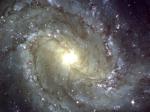 M83: The Southern Pinwheel Galaxy from VLT
M83: The Southern Pinwheel Galaxy from VLT
17.12.2005
M83 is one of the closest and brightest spiral galaxies on the sky. Visible with binoculars in the constellation of Hydra, majestic spiral arms have prompted its nickname as the Southern Pinwheel. Although discovered...
 Apollo 17: Last on the Moon
Apollo 17: Last on the Moon
16.12.2005
In December of 1972, Apollo 17 astronauts Eugene Cernan and Harrison Schmitt spent about 75 hours on the Moon, in the Taurus-Littrow valley, while colleague Ronald Evans orbited overhead. Near the beginning of their...
15.12.2005
Scroll right and gaze through the dusty plane of our Milky Way Galaxy in infrared light. The cosmic panorama is courtesy of the Galactic Legacy Infrared Mid-Plane Survey Extraordinaire (GLIMPSE) project and the Spitzer Space Telescope.
 Autumn Moon Encore
Autumn Moon Encore
14.12.2005
Near its northernmost declination, tonight's Full Moon will be a special one, arcing high in northern hemisphere skies. But a Full Moon won't occur on this calendar date for another 19 years, a period known as the lunar Metonic cycle.
 A Digital Opportunity Rover on Mars
A Digital Opportunity Rover on Mars
13.12.2005
If you could see one of the robot rovers currently rolling across Mars, what would it look like? To gain this perspective useful in planning explorations, the above synthetic image was produced digitally. Above...
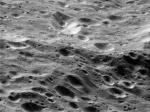 620 Kilometers Above Rhea
620 Kilometers Above Rhea
12.12.2005
What does the surface of Saturn's moon Rhea look like? To help find out, the robot Cassini spacecraft currently orbiting Saturn was directed to fly right past the second largest moon of the gas giant planet late last month.
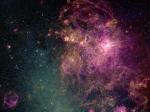 30 Doradus: The Tarantula Zone
30 Doradus: The Tarantula Zone
11.12.2005
The Tarantula Nebula is more than 1,000 light-years across - a giant emission nebula within our neighboring galaxy the Large Magellanic Cloud. Inside this cosmic arachnid lies a central young cluster of massivestars, cataloged as R136, whose intense radiation and strong winds have helped energize the nebular glow and shape the spidery filaments.
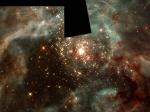 R136: The Massive Stars of 30 Doradus
R136: The Massive Stars of 30 Doradus
10.12.2005
In the center of star-forming region 30 Doradus lies a huge cluster of the largest, hottest, most massive stars known. These stars, known as the star cluster R136, and part of the surrounding nebula are captured here in this gorgeous visible-light image from the Hubble Space Telescope.
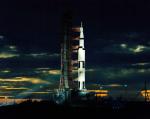 The Last Moon Shot
The Last Moon Shot
9.12.2005
In 1865 Jules Verne predicted the invention of a space capsule that could carry people. His science fiction story "From the Earth to the Moon" outlined his vision of a cannon in Florida so powerful that it could shoot a Projectile-Vehicle carrying three adventurers to the Moon.
|
January February March April May June July August September October November December |
|||||||||||||||||||||||||||||||||||||||||||||||||